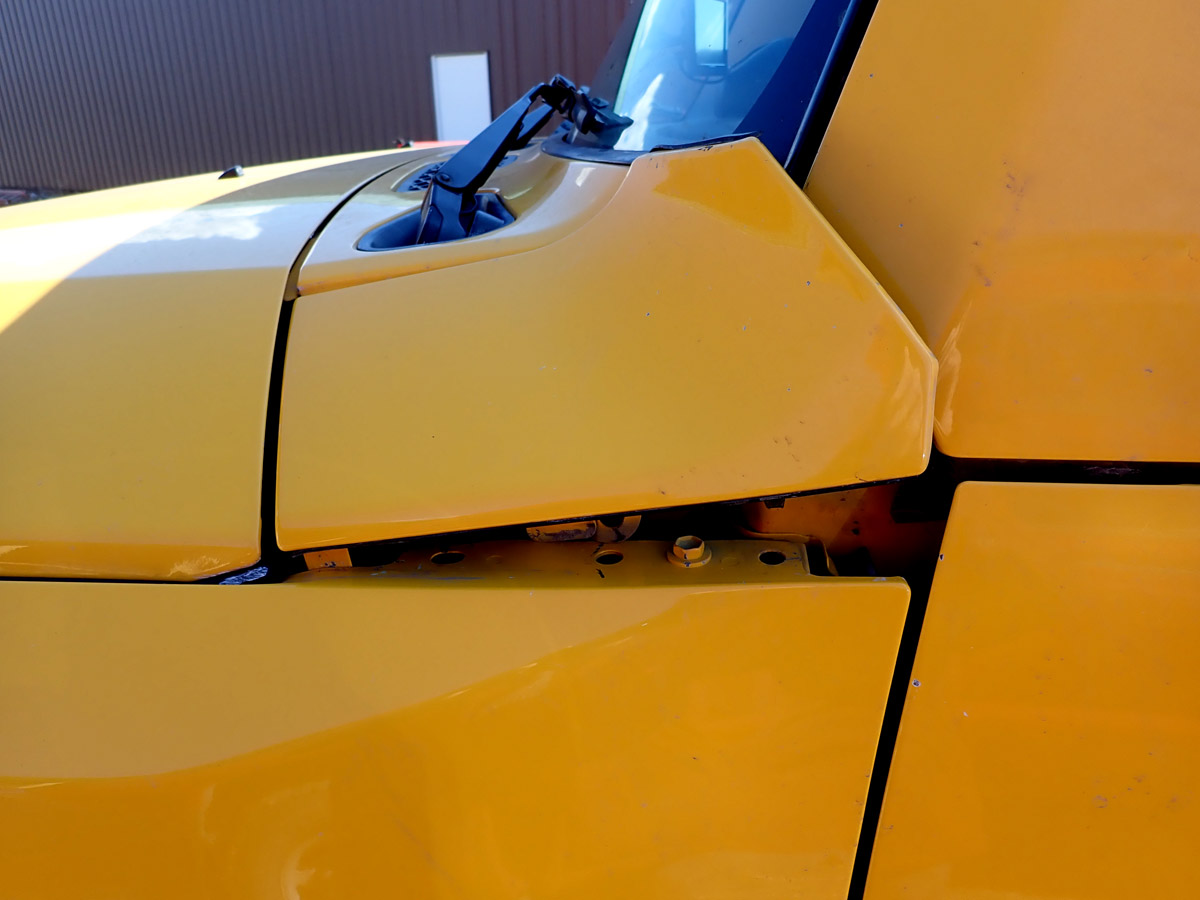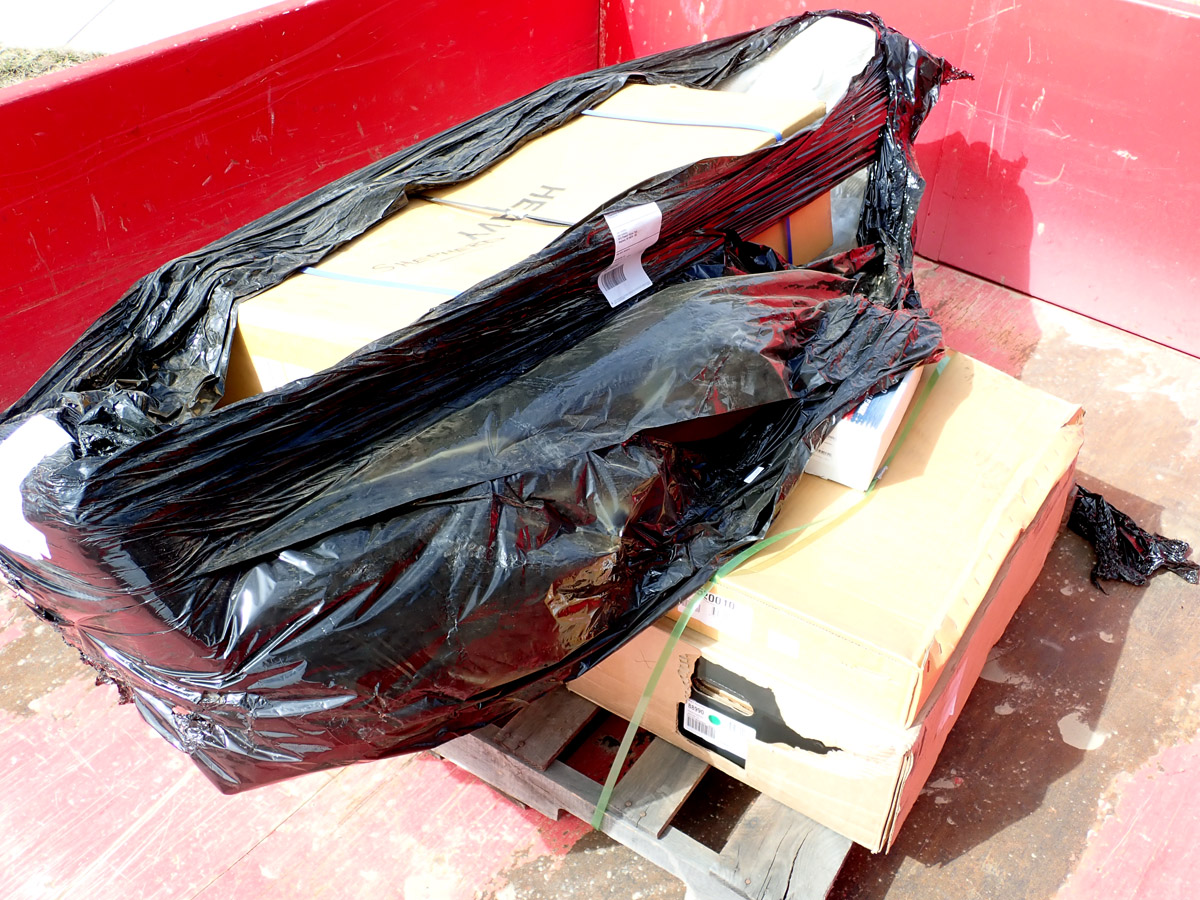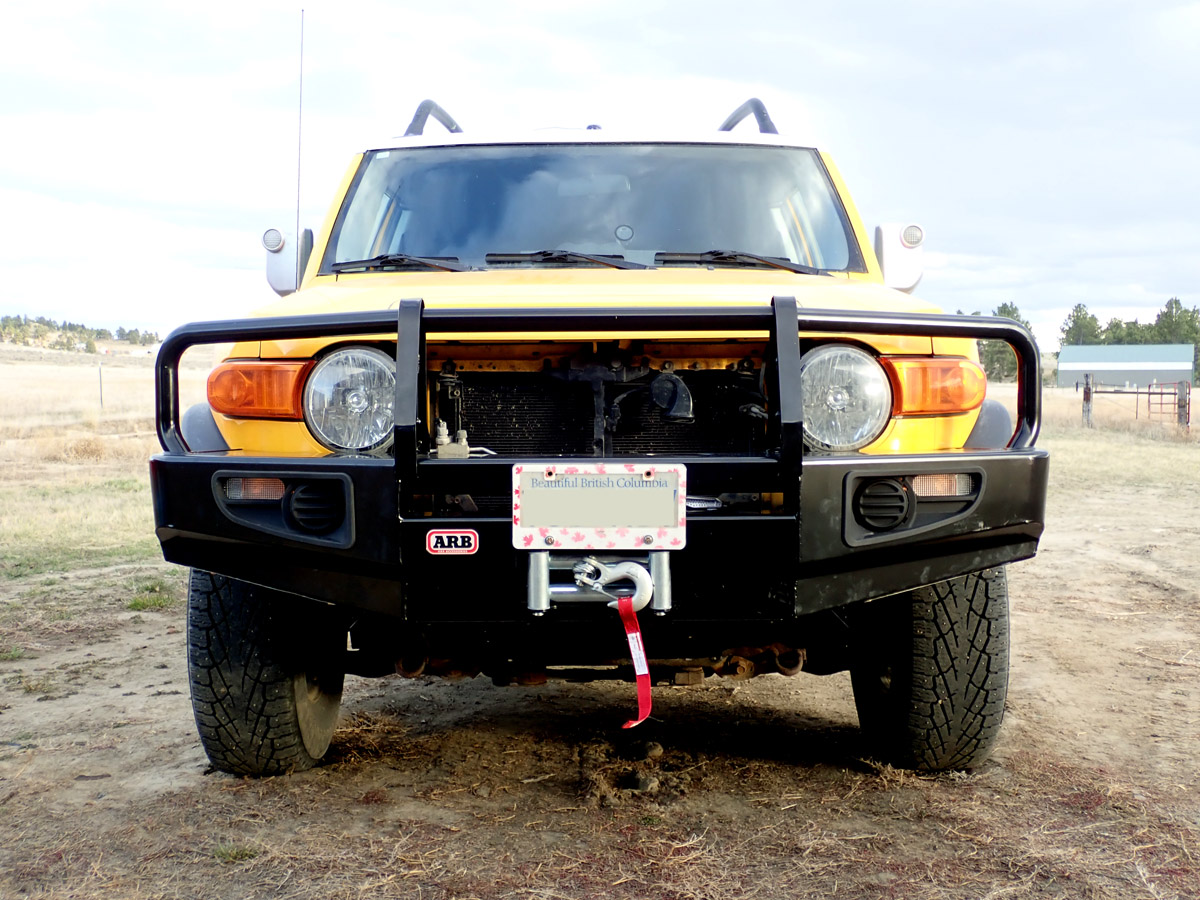
It matters not how careful you are on the poorly maintained bush roads of the interior of British Columbia: you will eventually drive onto a small mud puddle and discover that there’s a deep lake hiding under it. Good tires and traction devices will handle many of those “oops” moments, but not all of them. If you're actually out in the boondocks more than rarely, there will come a time when you are stuck. Bogged. Without additional assistance, your vehicle is not going anywhere in the foreseeable future.
THE WINCH
This means a winch isn’t a luxury, something hang onto the front bumper to give your rig a tactical look. It's there because its pulling power is going to drag you out of a bog somewhere. The FJ doesn’t (well, didn’t, since they’re no longer made) come with a winch. And that was a modification that I couldn’t do myself. It needed a new, very strong, front bumper to which a winch could be mounted; and of course a winch to mount thereunto. The winch didn’t need to be something that would drag the slightly less than 5,000 pounds of FJ across the Mojave or over the Andes; it would have to be something that could be used a few times a year to deal with mud, snow, and the occasional high spot.
As all gardeners know, growing plants lean toward the source of the light. Along logging roads, that means that willows, alders, and other brush grows out from the edge toward the center of the road, where the light is. Rather than go with the cheapest winch-ready bumper, I chose one that had bull bars to provide protection for the headlights and the forward edges of the fenders. It was a bit more initial cost, but body work is expensive, so I figured I’d save a bit in the long run.
The winch didn’t need to be the top of the line premium model, but it did need to be strong enough to pull the FJ from a muddy hole; and most importantly, it had to be reliable. There were brands that were less expensive, but I had used a Warn winch for a couple of decades without a single failure to operate, so I decided on that brand with a capacity of twice the dead vehicle weight of the FJ.
A winch needs a pulling power of at least one-and-a-half times the dead weight of the vehicle, and two times is better. When you’ve got your vehicle in a bog, it has no traction (if it did, you’d just drive out). Because the wheels aren’t resting on anything, your rig is sunk to at least the axles. When you pull it forward, it plows up all that lovely mud in a wave in front of the vehicle, so the amount you're pulling is the weight of the vehicle plus the weight of the mud in front of it, in the wheel wells, and in every other nook and cranny that isn’t sealed off. The FJ weighs close to 5,000 pounds, so I got a winch rated for 10,000 pounds.
Winch line is readily available in both steel wire rope and synthetics. The advantage of synthetics is that it is much lighter in weight and tends to take up less space on the spool. Its disadvantage is that it is readily abraded and degrades with UV exposure. I went with the traditional wire rope for long-term durability.
When I started looking for winch-ready bumpers for the FJ, it was obvious that the number of other changes and modifications that could be made was higher than I could count on all my fingers and toes combined, but I didn’t need them. I was preparing a general purpose vehicle, suitable for bush travel and more civilized venues, not something to tackle the Rubicon Trail.
ROAD TRIP
The interior of BC where I live is not well-served by the normal freight-delivery services such as FedEx or UPS. Luckily for me I have a good friend in Montana who accepted delivery of my bumper and winch that I ordered on line. To go get it, and get it installed, I had to drive the thousand miles one way, but that gave me the opportunity to get really acquainted with my FJ, shown below in pre-winch configuration.

Mileage
The FJ is boxy; aerodynamic it ain't. It does have a high compression engine at 10:1, whereas most car engines (such as the one on my old Jeep TJ) are lower-compression engines, in the range of 8:1. For the non-gearheads (which is most of us), that means that the compression inside the cylinders is higher (the gasoline vapor is packed in tighter) before the spark plug ignites it. That requires higher octane fuel (premium gas rather than standard grade). The computer that controls the Toyota 6-cylinder engine can, and does, sense when lower octane standard fuel is used and will ignite it at the proper compression, so the engine will run well and without harm, if you do use regular in it. The engine isn't as efficient then (because it isn't operating at its design specifications), so it gets lower mileage. From previous testing I did when it was new, in an urban setting, the difference wasn't enough to warrant paying the cost for premium gasoline. On a road trip, though, when the conditions called for a hard working engine, I wondered whether it was worth it.
I filled up with premium and started my road trip. With the first fill-up, most of the gas in the tank was regular, but even with that first tank I saw an improvement in mileage. With each tankful the regular gas was diluted, until by about the fourth tank, I was running pretty much pure premium gas, and mileage was between 4 and 5 miles per gallon better. This made a real difference because part of the trip was made on the Interstate highway across the Montana plains where the speed limit was 80 mph. I didn't need to go 80 to find out that the FJ would suck gas, but I was able to go about 70 mph with less than one mile per gallon reduction compared with doing 60. With that small a loss, I didn't have to sacrifice too much time.
As I said, the FJ is boxy. The windshield has only about a 10 degree rearward slant. A standard vehicle's windshield has a slant of 40 degrees or so. The more slanted the windshield, the more aerodynamic it is, and the less crap it catches, such as bugs and small rocks. We do live in a rural area, so there are more little pebbles on the road than in an urban area, which adds to the problem.
Another reason FJ windshields are more subject to rock damage than those of a lot of other vehicles is the method of installation. My old Jeep had the vertical windshield of the FJ, but it was inset into a rubber gasket that was in turn attached to the windshield frame. That rubber gasket helped dampen some of the vibrations set up when a rock hit the windshield. The FJ’s windshield, though, is simply glued tightly into the windshield frame with a urethane glue; there's nothing to dampen the vibrations so the glass has to take it all. My wife considered herself lucky to go three full years without having to have the windshield replaced because of cracks.

Paused at a rest stop
Unlike most vehicles, in the FJ some of the cowling (the small body plates in front of the windshield) must be removed before the windshield can be replaced. Then those pieces have to be put back on, lest rain, mud, and other environmental detritus get into the engine compartment. The little plastic clips that hold the cowls in place are single-use, supposed to be replaced when the cowls are pulled off. Some auto glass places do it, others don't. The last place where my wife had the windshield replaced (back when I was still driving my Jeep) tried to reuse the clips. It didn’t work well.

The cowling

The clips holding the cowling in place can be seen along its edge
Before I left to start the road trip, my wife had called my attention to the needed to replace the clips: caught early it is a cheap and easy fix, but if you let it go it changes into an expensive repair. If the clips come loose the cowl could flip off, bang down the highway, get dented, and have to be completely replaced. Toyota doesn't carry those cowls in all sorts of colors (body parts are like Model Ts; you can get them in any color you want as long as it's black). You have to take the replacement cowl to a body and paint shop and have it painted (yet another expense), then finally buy the replacement clips. It was easier and cheaper to just go buy the clips, pull the cowl off, yank out any pieces of old clip, and use the new ones to properly reinstall the cowl.
I made a slight detour into one of the larger Montana towns to the Toyota dealer and bought a pack of clips. Despite the FJ not having been made since 2014, the dealer still had packets of the four clips necessary because replacing them isn't an uncommon problem. I handed him $18 and was on my way. Now that I know exactly what clips I need, I can get them cheaper on line next time—and there undoubtedly will be a next time.
I did risk waiting until I got to my buddy's place, though. Moral support and any tools that I didn't have with me were an asset. As it happened, I didn’t need any esoteric tools. The cowl flipped up as it had done on too many occasions and I reached under it and released the two remaining clips. The task was then a simple one of removing the remaining bits of plastic and inserting the new clips. The cowl snapped down snugly and all was apparently copasetc.

Winch Installation
The bumper and winch, along with all the necessary mounting hardware was waiting for me when I got to my buddy’s place. It didn’t take us overly long to decide that we shouldn’t do the installation ourselves. Getting the factory bumper, mostly plastic, off didn’t look overly difficult but getting the new steel bumper on was different. We might have figured it out, and we might have done it properly, but there are always more wrong ways to do things than there are correct ways. If we flubbed it, all kinds of bad things might happen: and Mr. Murphy would ensure that I was miles out in the boondocks when they did. My buddy has some gearhead friends who revel in the intricacies off road machinery, and they were more than willing to lend us their expertise, up to and including the proper way to hook up the electrical connections to the winch so that even drawing a heavy electrical load, none of the wiring, new or old, would be stressed.



On The Road Again
With the modifications and adjustments completed, it was time for us to tend to the final detail of the reason for my trip; to visit family and friends one state to the west. My buddy and I convoyed from east central Montana to southwest Idaho through one of the windiest areas of what can a very windy state. The FJ, with its boxy shape, was pushed back by a 40 mph headwind. That coupled with a forward speed of a bit over 60 mph meant that the bodywork was buffeted by wind speeds of hurricane level. We pulled off into a rest stop and when I went back to the FJ I noticed that a slight gap had opened up at the base of the cowl. I gave it a solid push, heard the clips engage, and thought no more of it. Perhaps when I changed the clips I merely hadn't pushed hard enough.
Unfortunately, it was loose every time we stopped until we made it to the west side of the Rockies. By wiggling all the pieces of cowling, I could figure out the problem even though my x-ray vision was defective. The clips on the center piece of cowling were also broken, so when it rattled and flexed in the hurricane Class II wind, it forced the new clips I’d installed to spring loose. They all needed to be replaced.. With the liberal application of tape, I kept all the pieces attached to the FJ. Once we were over the Divide, the winds were much lighter and I didn’t have to worry about losing pieces of cowling. When we got to our destination, city, but hadn’t yet reached the hotel, I stopped at the major Toyota dealer. The service manager knew what the issue was without having to be told; the tape did the talking. He said, “You used the wrong autoglass place and they tried re-using the clips. We can have it for you in the morning.” And they did.
From then on, all my vehicular problems had been faced, analyzed, and cured. I was ready to return to the interior of British Columbia and put the FJ to work. It was a long drive, but one with no great surprises or uncertainties.
| HUNTING | GUNS | DOGS |
| FISHING & BOATING | TRIP REPORTS | MISCELLANEOUS ESSAYS |
| CONTRIBUTIONS FROM OTHER WRITERS|
| RECIPES |POLITICS |